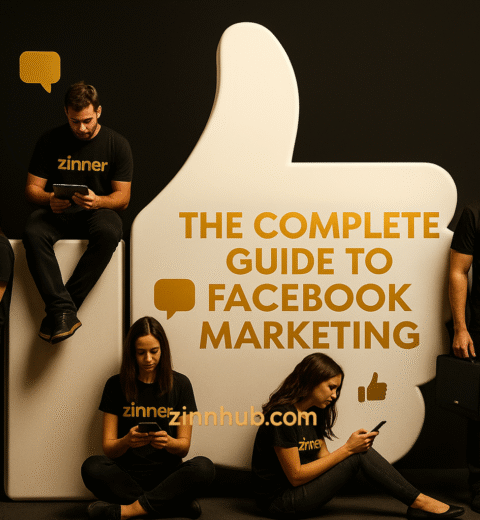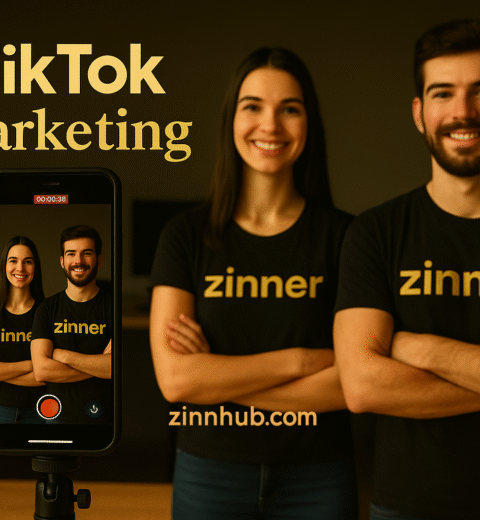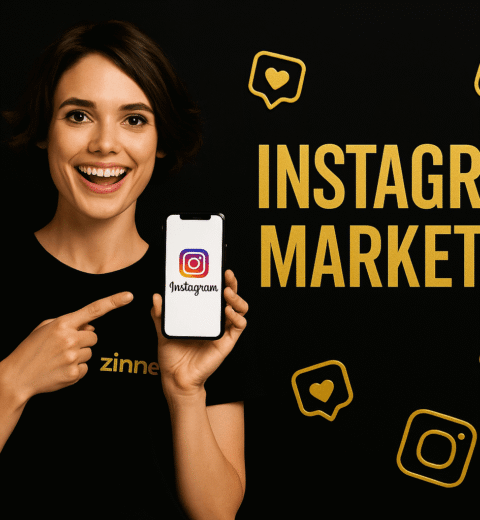Table of Contents
- 1. Verify That Your website Is Prepared For Selling
- 2. Use SEO to Get Found Online for Free
- 3. Get Fast Results with Paid Advertising (PPC)
- 4. Develop an Email List Right Away
- 5. Pay Attention to Marketplaces
- 6. Use Social Media, But Choose Your Channels Carefully
- 7. Monitor What Is and Is Not Working
- 8. Seek Assistance From Reliable Freelancers
- 9. Display Your Items in Google Photos & Search
- 10. Include Features That Help Your Website Convert
Although launching an eCommerce company is thrilling, it can also feel like an uphill battle, let us admit it. In what ways can a small business distinguish itself when large brands dominate social media and Google?
What’s the good news? You are able to compete! Even if you are just starting out or have limited resources, you can increase sales, expand your audience, and create a lasting brand with the correct digital marketing strategy.
This straightforward, useful guide will assist you in doing just that.
1. Verify That Your website Is Prepared For Selling
Examine your website thoroughly before you begin promoting anything. Is it fulfilling its purpose?
Consider this:
- Does it look perfect on a mobile device?
- Does it load quickly?
- Is it possible for people to find what they need quickly?
- Would you be at ease making purchases from it?
These fundamentals have a significant impact. Consider your website as your online shopfront; if it is clunky or slow, visitors will leave before you have an opportunity to finalise the sale.

2. Use SEO to Get Found Online for Free
Although search engine optimisation (SEO) may sound technical, its fundamental goal is to make your products more visible to online searchers.
You can begin modestly:
- Incorporate organic keywords into the titles and descriptions of your products.
- Include blog entries that compare products or provide answers to frequently asked questions.
- Make sure your website loads quickly and that your images have alt text.
Good SEO eventually generates free, high-quality traffic. No advertising budget is needed.
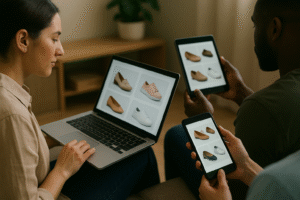
3. Get Fast Results with Paid Advertising (PPC)
Paid advertising, sometimes referred to as PPC (Pay-Per-Click), can immediately bring targeted customers to your store, while SEO takes time to develop.
PPC enables you to reach consumers who are prepared to make a purchase, regardless of how much money you have to spend on advertising. The secret is to start small, experiment with various strategies, and improve as you go.
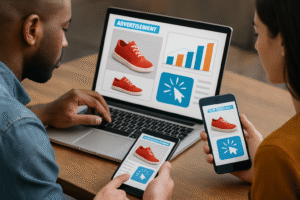
Several clever PPC choices for online retailers:
Ads for Google Shopping
When people are actively searching for your products, display them at the top of search results. It is among the most effective strategies for connecting with high-intent buyers.
Ads on Facebook and Instagram
These work well for visual storytelling and audience targeting based on lookalikes, behaviour, or interests. They are particularly effective in increasing awareness and encouraging impulsive purchases.
Retargeting Advertising
These advertisements remind users to return and finish their purchase after they have already left your website without making a purchase. They are frequently your most economical conversions.
What is so great about PPC? Clicks, expenses, and conversions can all be tracked, and performance can be swiftly adjusted. When done correctly, it is one of the quickest ways to see results.
4. Develop an Email List Right Away
You are losing money if you do not collect emails from the outset.
If you do not have a way to connect with them, people may visit your site once and never return. Offer a discount, freebie, or useful guide in return for an email using a pop-up or sign-up bar.
Next, maintain contact with:
- A series of welcome emails
- Reminders for cart abandonment
- Monthly or weekly discount sales
One of the most successful marketing channels available is email marketing, which also gives you complete control over your audience.
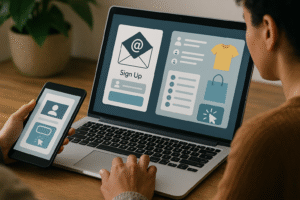
5. Pay Attention to Marketplaces
You can quickly get your products in front of customers with the help of marketplaces like Amazon, Etsy, or eBay, especially if your website is just getting started.
You gain access to millions of customers, immediate visibility, and inherent trust. However, it is not all sunshine and savings.
Pros of Marketplace Selling:
- Quick access to a large audience
- You do not have to worry about starting from scratch to increase traffic.
- First sales are easier on trusted platforms.
- Excellent for evaluating product-market fit
Cons of Marketplace Selling:
- Costly commissions and fees
- The customer relationship is not yours.
- Your brand is overshadowed by competing companies.
- Limited authority over branding and design
Top Tip: Drive customers to your own website, where you have complete control, after using marketplaces to boost sales.

6. Use Social Media, But Choose Your Channels Carefully
Only use the social media channels that are appropriate for your audience and brand; you do not have to be active on all of them. Every channel has advantages; the secret is to choose the one that best suits your voice and your products.
Here is a brief guide to assist you in making a decision:
Instagram: is ideal for visual brands in the food, beauty, fashion, and décor industries.
Facebook: Excellent for creating communities, running ads, and reaching older demographics.
TikTok: Perfect for products that are trendy, quirky, or visually appealing.
Pinterest: is the greatest platform for evergreen content and discovery-based shopping.
LinkedIn: If you sell professional tools, services, or business-to-business (B2B) goods.
YouTube: Great for long-form content, tutorials, and product demos.
Select one or two platforms, be present on a regular basis, and concentrate on interaction rather than just advertising.

7. Monitor What Is and Is Not Working
A little tracking goes a long way, but you do not have to be a data nerd.
Utilise resources such as Hotjar, Meta Pixel, or Google Analytics to discover:
- The source of your traffic
- What are your best-performing products or pages?
- Where customers leave during the purchasing process
- Which advertising campaigns are genuinely generating leads?
You can avoid wasting time or money by using data to inform your decisions.
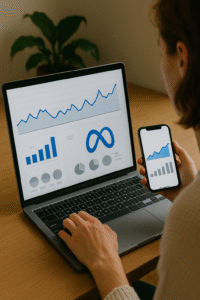
8. Seek Assistance From Reliable Freelancers
You can not do everything on your own. You should not have to, either! You can hire skilled freelancers to help you with your SEO, social media, website design, content writing, or digital marketing without going over budget.
Zinners, at Zinn Hub Marketplace, are adept at assisting small eCommerce companies in expanding. They understand what it takes to gain traction online and are adaptable and reasonably priced.
You can concentrate on what you do best – managing your business – by outsourcing the tasks you are stuck on.
👉 Look through Zinners on the Zinn Hub Marketplace
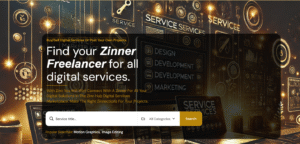
9. Display Your Items in Google Photos & Search
Making sure your product listings show up directly in Google Search and Google Images (where people are actually shopping!) is a potent but frequently overlooked tactic.
You can now update your listings in real time, which helps your products show up in the right places at the right times, thanks to changes made to Google’s product feed system.
Whether you sell exclusive drops, popular items, or seasonal collections, you can now:
- appear in Google Images and Google Shopping.
- Automatically sync your inventory
- Reach customers who are highly likely to make a purchase.
To begin:
- Make an account on Google Merchant Centre.
- Upload your product feed, or sync it with WooCommerce, Shopify, and other platforms.
- Provide precise product information, such as titles, costs, pictures, and descriptions.
- Make sure Google’s shopping policies are followed by your website.
It is a free, low-effort, high-reward strategy to raise visibility and attract more targeted visitors.
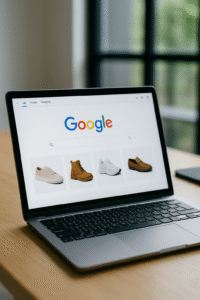
10. Include Features That Help Your Website Convert
A stunning eCommerce website is fantastic, but if it lacks the features users anticipate, they will quickly leave. Because consumers are more discerning and knowledgeable than ever, your website must be user-friendly, informative, and conversion-optimised.
A list of essential features for any serious online store is provided below:
🧭 The Shopping and Navigation Experience
- Breadcrumbs for easy navigation
- Internal search function
- Filtering products by price, size, colour, etc.
- Navigation in the footer is well-organised.
- Product Pages With Product Videos
- Comparing products side by side
- Reviews from customers
- FAQs
- Generous and transparent return policies
💸 Simple, Reliable Checkout
- Easy checkout procedure
- Several methods of payment, including mobile wallets
- SSO login (Apple, Facebook, Google)
- Order tracking in real time
📲 Engagement & Mobile Tools
- Optional mobile application
- Opt-ins for SMS and email
- Push alerts
- Live chat assistance or chatbots
💥 Growth Features
- Coupons and exclusive deals
- Programs for rewards or loyalty
- Wishlist and gift registry features
- Options for affiliate marketing
- Local store information in multiple languages
- Privacy policy and personal data
🔥Bonus: Modern Integrations
- Carousels for sales or highlighted/featured items on the homepage
- Integration of TikTok Shop for social-first marketing
Today’s consumers expect these features. Make sure they have an incentive to stay, make a purchase, and return to your store. However, keep in mind that the most successful brands took time to achieve their success. Like you, they built one step at a time.
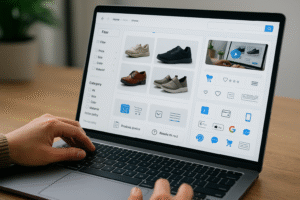
Do You Need Someone to Help You Develop Your E-Commerce Website?
At Zinn Digital, freelancers assist small businesses in increasing their online visibility, sales, and visibility. We can help you whether you need a website, a comprehensive marketing strategy, or a few tweaks to get your funnel moving.
Digital marketing doesn’t have to be expensive or overwhelming. All you need is a well-thought-out plan, the appropriate Zinner, and the perseverance to try, test, and repeat

